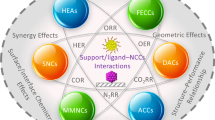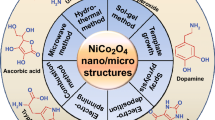Abstract
A novel enzyme-free electrochemical sensor for H2O2 was fabricated by modifying an indium tin oxide (ITO) support with (3-aminopropyl) trimethoxysilane to yield an interface for the assembly of colloidal gold. Gold nanoparticles (AuNPs) were then immobilized on the substrate via self-assembly. Atomic force microscopy showed the presence of a monolayer of well-dispersed AuNPs with an average size of ~4 nm. The electrochemical behavior of the resultant AuNP/ITO-modified electrode and its response to hydrogen peroxide were studied by cyclic voltammetry. This non-enzymatic and mediator-free electrode exhibits a linear response in the range from 3.0 × 10−5 M to 1.0 × 10−3 M (M = mol · L−1) with a correlation coefficient of 0.999. The limit of detection is as low as 10 nM (for S/N = 3). The sensor is stable, gives well reproducible results, and is deemed to represent a promising tool for electrochemical sensing.

AuNPs/ITO modified electrode prepared by self-assembly method exhibit good electrocatalytic activity towards enzyme-free detection H2O2. The linear range of typical electrode is between 3.0 × 10−5 M and 1.0 × 10−3 M with a correlation coefficient of 0.999 and the limit detection is down to 1.0 × 10−8 M.








Similar content being viewed by others

References
Wolanov Y, Prikhodchenko PV, Medvedev AG, Pedahzur R, Lev O (2013) Zinc dioxide nanoparticulates: a hydrogen peroxide source at moderate pH. Environ Sci Technol 47:8769–8774
Cui Y, Zhang B, Liu BQ, Chen HF, Chen GN, Tang DP (2011) Sensitive detection of hydrogen peroxide in foodstuff using an organic–inorganic hybrid multilayer-functionalized graphene biosensing platform. Microchim Acta 174:137–144
Liu Y, Sun GZ, Jiang CB, Zheng XT, Zheng LX, Li CM (2013) Highly sensitive detection of hydrogen peroxide at a carbon nanotube fiber microelectrode coated with palladium nanoparticles. Microchim Acta. doi:10.1007/s00604-013-1066-8
Önal Y, Schimpf S, Claus P (2004) Structure sensitivity and kinetics of D-glucose oxidation to D-gluconic acid over carbon-supported gold catalysts. J Catal 223:122–133
Schäferling M, Grögel DBM, Schreml S (2011) Luminescent probes for detection and imaging of hydrogen peroxide. Microchim Acta 174:1–18
Cao XH, Zeng ZY, Shi WH, Yep P, Yan QY, Zhang H (2013) Three-dimensional graphene network composites for detection of hydrogen peroxide. Small 9:1703–1707
Li F, Zhao Q, Wang C, Lu XF, Li XF, Le XC (2010) Detection of Escherichia coli O157:H7 using gold nanoparticle labeling and inductively coupled plasma mass spectrometry. Anal Chem 82:3399–3403
Lu WT, Arumugam SR, Senapati D, Singh AK, Arbneshi T, Khan SA, Yu HT, Ray PC (2010) Multifunctional oval-shaped gold-nanoparticle-based selective detection of breast cancer cells using simple colorimetric and highly sensitive two-photon scattering assay. ACS Nano 4:1739–1749
Zhao WA, Ali MM, Aguirre SD, Brook MA, Li YF (2013) Enzyme sensor based on carbon nanotubes/cobalt(II) phthalocyanine and tyrosinase used in pharmaceutical analysis. Sensors Actuators B 177:138–144
Guo LH, Xu Y, Ferhan AR, Chen GN, Kim DH (2013) Oriented gold nanoparticle aggregation for colorimetric sensors with surprisingly high analytical figures of merit. J Am Chem Soc 135:12338–12345
Zheng YJ, Huang ZJ, Chen J, Wang K, Liu AL, Lin XH, Zheng W (2013) Enzyme-based E-RNA sensor array with a hairpin probe: specific detection of gene mutation. Sensors Actuators B 181:227–233
Won YH, Huh K, Stanciu LA (2011) Au nanospheres and nanorods for enzyme-free electrochemical biosensor applications. Biosens Bioelectron 26:4514–4519
Lu WB, Liao F, Luo YL, Chang GH, Sun XP (2011) Hydrothermal synthesis of well-stable silver nanoparticles and their application for enzymeless hydrogen peroxide detection. Electrochim Acta 56:2295–2298
Wang QX, Zhang HL, Wu YW, Yu AM (2012) Amperometric hydrogen peroxide biosensor based on a glassy carbon electrode modified with polythionineand gold nanoparticles. Microchim Acta 176:279–285
Bui MPN, Pham XH, Han KN, Li CA, Kim YS, Seong GH (2010) Electrocatalytic reduction of hydrogen peroxide by silver particles patterned onsingle-walled carbon nanotubes. Sensors Actuators B 150:436–441
Singh RP, Pandey AC (2011) Silver nanosieve using 1,2-benzenedicarboxylic acid: a sensor for detection of hydrogen peroxide. Anal Methods 3:586–592
Salinas Y, Manez RM, Marcos MD, Sancenon F, Costero AM, Parra M, Gil S (2012) Optical chemosensors and reagents to detect explosives. Chem Soc Rev 41:1261–1296
Liana DD, Raguse B, Wieczorek L, Baxter GR, Chuah K, Gooding JJ, Chow E (2013) Sintered gold nanoparticles as an electrode material for paper-based electrochemical sensors. RSC Adv 3:8683–8691
Lu YH, Chen W (2012) Sub-nanometre sized metal clusters: from synthetic challenges to the unique property discoveries. Chem Soc Rev 41:3594–3623
Zhang QX, Ren QQ, Miao YQ, Yuan JH, Wang KK, Li FH, Han DX, Niu L (2012) One-step synthesis of graphene/polyallylamine-Au nanocomposites and their electrocatalysis toward oxygen reduction. Talanta 89:391–395
Xiao Y, Ju HX, Chen HY (2000) Direct electrochemistry of horseradish peroxidase immobilized on a colloid/cysteamine-modified gold electrode. Anal Biochem 278:22–28
Daniel MC, Astruc D (2004) Gold nanoparticles: assembly, supramolecular chemistry, quantum-size-related properties, and applications toward biology, catalysis, and nanotechnology. Chem Rev 104:293–346
Ishida T, Haruta M (2007) Gold catalysts: towards sustainable chemistry. Angew Chem Int Ed 46:7154–7156
Toyota A, Sagara T (2008) Particle size dependence of the charging of Au nanoparticles immobilized on a modified ITO electrode. Electrochim Acta 53:2553–2559
Oyama M, Orimo A, Nouneh K (2009) Effects of linker molecules on the attachment and growth of gold nanoparticles on indium tin oxide surfaces. Electrochim Acta 54:5042–5047
Yang J, Ichii T, Murase K, Sugimura H (2012) Site-selective assembly and reorganization of gold nanoparticles along aminosilane-covered nanolines prepared on indium-tin oxide. Langmuir 28:7579–7584
Wang JW, Wang LP, Di JW, Tu YF (2009) Electrodeposition of gold nanoparticles on indium/tin oxide electrode for fabrication of a disposable hydrogen peroxide biosensor. Talanta 77:1454–1459
Ma Y, Di JW, Yan X, Zhao ML, Lu ZJ, Tu YF (2009) Direct electrodeposition of gold nanoparticles on indium tin oxide surface and its application. Biosens Bioelectron 24:1480–1483
Zhang JD, Oyama M (2005) Gold nanoparticle-attached ITO as a biocompatible matrix for myoglobin immobilization: direct electrochemistry and catalysis to hydrogen peroxide. J Electroanal Chem 577:273–279
Harris JJ, Bruening ML (2000) Electrochemical and in situ ellipsometric investigation of the permeability and stability of layered polyelectrolyte films. Langmuir 16:2006–2013
Chen ZF, Zu YB (2007) Gold nanoparticle-modified ITO electrode for electrogenerated chemiluminescence: well-preserved transparency and highly enhanced activity. Langmuir 23:11387–11390
Kumar SA, Wang SF, Chang YT (2010) Poly(BCB)/Au-nanoparticles hybrid film modified electrode: preparation, characterization and its application as a non-enzymatic sensor. Thin Solid Films 518:5832–5838
Kumar SA, Wang SF, Chang YT (2011) Au nanocages for highly sensitive and selective detection of H2O2. J Electroanal Chem 656:23–28
Liu RJ, Li SW, Yu XL, Zhang GJ, Zhang SJ, Yao JN, Keita B, Nadjo L, Zhi LJ (2012) Facile synthesis of Au-nanoparticle/polyoxometalate/graphene tricomponent nanohybrids: an enzyme-free electrochemical biosensor for hydrogen peroxide. Small 8:1398–1406
Chen SH, Yuan R, Chai YQ, Hu FX (2013) Electrochemical sensing of hydrogen peroxide using metal nanoparticles: a review. Microchim Acta 180:15–32
Wang GF, He XP, Wang LL, Gu AX, Huang Y, Fang B, Geng BY, Zhang XJ (2013) Non-enzymatic electrochemical sensing of glucose. Microchim Acta 180:161–186
Hu XY, Xiao Y, Chen HY (1999) Adsorption characteristics of Fe(CN)6 3−/4− on Au colloids as monolayer films on cysteamine-modified gold electrode. J Electroanal Chem 466:26–30
Maduraiveeran G, Ramaraj R (2007) Gold nanoparticles embedded in silica sol–gel matrix as an amperometric sensor for hydrogen peroxide. J Electroanal Chem 608:52–58
Li JJ, Yuan R, Chai YQ, Che X, Li WJ, Zhong X (2011) Nonenzymatic glucose sensor based on a glassy carbon electrode modified with chains of platinum hollow nanoparticles and porous gold nanoparticles in a chitosan membrane. Microchim Acta 172:163–169
Inasaki T, Kobayashi S (2009) Particle size effects of gold on the kinetics of the oxygen reduction at chemically prepared Au/C catalysts. Electrochim Acta 54:4893–4897
Janssens TVW, Clausen BS, Hvolbæk B, Falsig H, Christensen CH, Bligaard T, Nørskov JK (2007) Insights into the reactivity of supported Au nanoparticles: combining theory and experiments. Top Catal 44:15–26
Acknowledgement
The project was supported by the National Natural Science Foundation of China (No. 21071113), the Natural Science Foundation of Hubei Province (No. 2011CDA049), the International Cooperation Foundation of Hubei Province (No. 2012IHA00201) and the Scientific Innovation Team Project of Hubei Provincial Department of Education (T201306).
Author information
Authors and Affiliations
Corresponding author
Rights and permissions
About this article
Cite this article
Xiong, W., Qu, Q. & Liu, S. Self-assembly of ultra-small gold nanoparticles on an indium tin oxide electrode for the enzyme-free detection of hydrogen peroxide. Microchim Acta 181, 983–989 (2014). https://doi.org/10.1007/s00604-014-1189-6
Received:
Accepted:
Published:
Issue Date:
DOI: https://doi.org/10.1007/s00604-014-1189-6



